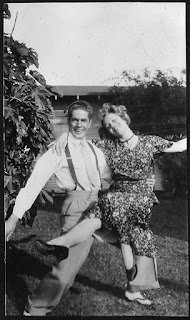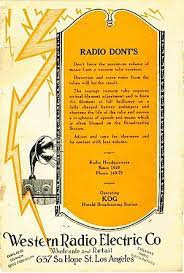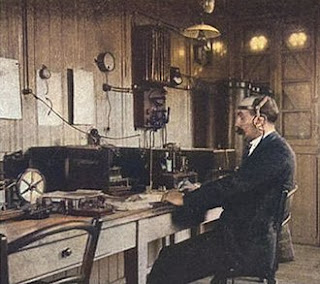“Someday” is what most of us say when it comes to going through mementos left behind by parents. Well, that “someday” came to me when I went through the boxes of items left behind by my husband’s parents. Among the “treasures” I found was a story/letter written to Paul and Hilda Burnett by Paul’s Aunt Ellen in 1987. Paul is the 8-year-old mentioned. Vera and Jim are his parents. Buel his uncle, Vera’s brother.
Red Handlebars – A
Depression Era Christmas
By Ellen Payne
In looking
back through the years, I remember that lack of money didn’t stop the
enthusiasm for making the best of things. Times were hard during the Great Depression but
we weren’t willing to give up and our sense of humor always stayed with us. During the
Christmas season of 1932, I was living with my future sister-in-law, Vera and
her husband Jim, in Long Beach. My fiancé Buel and I were both professional
dancers and were getting a dance act together at the time when the bottom was
falling out of show business. Theaters and night clubs were closing by the
dozen and backers were no longer around. 
Buel and Ellen
As
Christmas neared, we were all very broke. The only one who could count on a
gift was Paul, Vera and Jim’s eight-year-old son, who was still pretending he
believed in Santa Claus. In the spirit of the season, the rest of us
facetiously made out a fantasy list of our desires. My Buel concluded his by
specifying that it had to have “RED HANDLEBARS.” By
Christmas Eve we had managed to find money to buy a little Christmas tree, but there
were no gifts to place underneath, except those that Santa would later bring
Paul. There was a promise, however, of a good meal for Christmas day for which
we were all grateful, knowing that Grandma and Grandpa would be able to join
us. Young Paul was getting very excited
about the night to come. With Jim distracting Paul, Buel sneaked around the
house, rang the doorbell, and in a disguised voice, loud enough for Paul to
hear, indicated that Santa was in the neighborhood and would come later when all
the children were asleep. I never saw a little boy, who usually was reluctant
to go to bed, jump into bed so fast as he heard the New England sleigh bells,
which Buel jingled as he went down the street.
Things looked bleak,
for Buel and Ellen
when the club failed to open.
Hollywood Citizen
News 10/5/1932
With the
young one in bed, the adults got busy. Out came a train and a few other toys.
The men became so involved in setting up the train, like little boys themselves,
they had to be reminded they could ‘play train’ with Paul in the morning. The
Christmas spirit overwhelmed us, and we four decided to look around the house
for things to wrap for each other, to put under the tree for laughs. While the
others were busy, I took a flashlight and went to the garage to see if I could
find something useful there. It was like most garages filled with boxes, tools
and cast offs. Along one of the walls, behind a carton, I saw an old well-used,
outgrown scooter, handles still on it. A search through paint cans revealed a
partial can of red, quick dry enamel. I was in luck! Before I went into the
house, I spotted an old golf bag and some golf shoes which Jim hadn’t used for
months because he was putting all his time into starting an appraisal business.
In one pocket were some tees, so an idea formed quickly as I returned to the
house. Vera and
Buel were wrapping their treasures and were soon finished, so I said goodnight to
Buel, who lived a block away. I reminded him how much earlier than usual Paul
would probably get up, and said to expect an early morning phone call to start
the beginning of what would most certainly be a long, but enjoyable, day. As Vera
joined Jim for a much needed rest, I brought my finds into the house, painted
the scooter handles, wrapped the golf shoes and tees and put verses on the tags
for the finishing touches. I had found a new, forgotten baking pan in a little
used cupboard, so that finished my list of gifts. At last,
everything was quiet but I don’t think we got much sleep before daylight when a
little voice said “Momma, can we get up now?” A call to
Buel, and he was there within minutes. We watched Paul delightedly set the
train into motion and look over the other little toys waiting for him, he was a
happy little boy. Many laughs
ensued with the usual things we found to exchange, and our attempts at poetry.
I received an embroidery hoop from Vera and Jim with a home-made picture drawn
on a piece of white cloth stretched on it and a few strands of varicolored
thread. The verse attached read:Now go ahead and sew
while we’re playing Bridge,You like to be the
DummyBut you too still,
seem bound to winGuess we’d have more
luck with Rummy. The pan I wrapped for Vera had this
one on it:What do ya know, I
found this panAnd with it there’s a
planYour cakes so
delicious please your manAs well as we, who
are also your fans. For Jim,
who was surprised to see his old shoes and tees:Meet your old shoes
and golfing tees,Tis long since you
have used themRelax for awhile, go
on a spreeWe’ll cover you ‘till
5 p.m. Buel had
spied the red handlebars behind a big chair. Hanging on them was this little
blurb:Since I know that you
have no car.And you have big
plans to go so farUse this scooter to
get your tharIt has for sure, RED
HANDLEBARS When I look back at things worth remembering, this was a
highlight. More affluent times followed but I still can recall the excitement
and hear the belly laughs of that Christmas. Oh yes, Buel’s gift to me was an envelope with money which
he said to save for our wedding.
 |
| Buel and Ellen |
As Christmas neared, we were all very broke. The only one who could count on a gift was Paul, Vera and Jim’s eight-year-old son, who was still pretending he believed in Santa Claus. In the spirit of the season, the rest of us facetiously made out a fantasy list of our desires. My Buel concluded his by specifying that it had to have “RED HANDLEBARS.”
 |
| Things looked bleak, for Buel and Ellen when the club failed to open. Hollywood Citizen News 10/5/1932 |













_at_Brest,_France_(30091927581).jpg)


